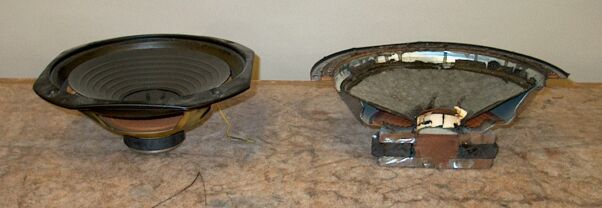

The speaker at left has the surround (the flexible joint that connects the upper edge of the cone to the basket) cut away, so that it is easier to see the motion of the cone when you drive the speaker with a low-frequency sine wave. It also has the cap at the center of the cone removed, so that you can see the voice coil riding up and down around the central magnet pole. At right is one half of a speaker that has been cut in two. Though some of the parts were mangled in this effort, you can show the various parts and describe their function.
A loudspeaker, or speaker, is a device that converts an electrical audio signal into mechanical motion that produces a sound wave. There is some variety in speaker design, but perhaps the most common, and probably the oldest type of speaker, is that which uses a magnet and voice coil to drive a conical diaphragm. The animated graphic below shows the various parts of such a speaker:
At the rear of the speaker is a circular magnet with a hole in its center, with two pole pieces fixed to it. These together form a circular channel in which the voice coil rides. The magnet and pole pieces are fixed to the back of the frame, or basket. The voice coil is held in place by a piece of stiff fabric with concentric accordion folds in it, called a spider. The tube on which the voice coil is wound is glued to the center hole of the spider, the outer edge of which is affixed to the basket. The outer end of this tube is attached to the center of the speaker cone. Usually, it fits within a hole at the back of the cone, and it is glued there. The outer edge of the cone is attached to the rim of the basket by a flexible piece, usually of rubber, called the surround. (Sometimes it is just one or two accordion folds in the cone, the outer edge of which is itself mounted to the basket.) The surround and the spider keep the voice coil and cone centered, but allow them to move in and out along the center axis. The wires to connect the voice coil run along the tube, to two points on the back of the cone, where they are glued in place. Here, they are attached to two flexible leads, which run to two terminals on a tab mounted to the basket.
The magnet is polarized across its thickness; one face is north and the other is south. Thus, the inner and outer pole pieces (between which is a cylindrical space) are opposite poles, and the magnetic field formed by them is radially directed. That is, the field lines run along radii of the circles about the center of the pole pieces. The turns of the voice coil thus run perpendicular to the magnetic field, so that when a current passes through the coil, the coil is forced either inward or outward along the axis; qv × B (il × B) points along the central axis of the speaker. When an audio signal is applied to the speaker terminals, the fluctuating current that this produces in the voice coil sets it and the cone oscillating, which imparts an oscillatory motion to the air in front of the cone. We hear the resulting pattern of compressions and rarefactions as sound.
By convention, the terminals on speakers are labeled so that if, relative to the other terminal, a positive voltage is applied to the one labeled “+”, the speaker cone moves outward. For a single speaker this does not matter at all. If two or more speakers are operating together, however, for best operation they must be connected so that they operate in phase with each other. (See demonstration 44.31 -- Interference of sound wave, phase.)